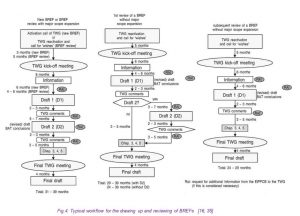Lesson 2 – PROCEDURE FOR THE DRAWING UP AND REVIEWING OF BREFs
Lesson Overview: In this lesson, we will explore the general procedure for drafting and reviewing Best Available Techniques Reference Documents (BREFs), which are essential guidelines for industrial installations within the European Union. BREFs provide valuable information on best practices to minimize pollution and ensure sustainable industrial activities. The process involves formal drafts, meetings, and information exchange to maintain the accuracy and relevance of these documents.
Lesson Objectives: By the end of this lesson, learners will be able to:
- Understand the workflow for drafting a new BREF.
- Recognize the steps involved in reviewing an existing BREF.
- Analyze the timing and variations in the process based on the scope and complexity of the BREF.
- Appreciate the importance of routine reviews and updates to ensure effective implementation.
Lesson Content:
- General Procedure for Drawing Up a New BREF
The process of drafting a new BREF begins with the identification of activities not covered in the previous versions. These newly drafted BREFs require extensive information collection. Typically, two formal drafts are expected before the final Technical Working Group (TWG) meeting. During a BREF review, TWG members are nominated to provide valuable inputs, and a background paper is distributed beforehand to structure the discussions effectively. The review focuses on updating fundamental information, eliminating outdated content, and correcting errors. Particular attention is given to the chapters related to “Techniques to consider in the determination of BAT,” “Best available techniques (BAT) conclusions,” and “Emerging techniques” to ensure they remain consistent, up-to-date, and achievable.
- General Procedure for the Review of a BREF
BREFs must be routinely reviewed to consider changes and their implications for Best Available Techniques (BAT). This involves assessing the “New Techniques” chapter and the section on “Concluding Remarks and Recommendations for Future Work.” The scope of the BREF may be extended, new techniques might be introduced, and uncovered products, substances, or processes may be incorporated during the review.
- Workflow for the Drawing Up and Reviewing of BREFs
The timing and steps in the process depend on factors such as the BREF’s scope, complexity, and the level of participation from the Technical Working Group. Three workflow variants are used, depending on the BREF type:
- For a new BREF or a major expansion of scope, two formal proposals are usually considered, taking between 31 and 39 months. b. For the first BREF review without a major expansion of scope, one or two formal proposals might be necessary, with a process duration between 24 and 39 months. c. For subsequent BREF reviews without a major scope expansion, one formal draft is expected, with a process duration between 24 and 29 months.
The Technical Working Groups and the European IPPC Bureau adapt these workflow variants based on specific BREF requirements and experiences from previous drafts and reviews. This ensures that BREFs are updated regularly, aligning with the directive’s objective to update them every eight years.

Conclusion:
Maintaining accurate and updated BREFs is crucial for promoting sustainable industrial practices and minimizing pollution. The process of drafting and reviewing BREFs involves collaboration, research, and adherence to set timelines. By following the general procedure and adapting the workflow to specific BREFs, we can ensure effective implementation and compliance with EU regulations.